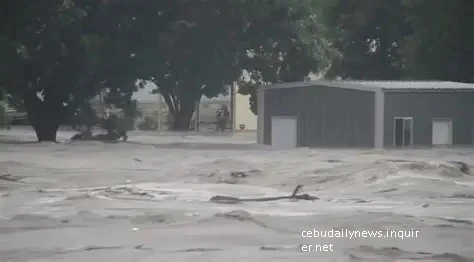An overnight flash flood devastated central Texas on July 4, claiming at least 24 lives and leaving approximately 23 girls missing at Camp Mystic. Torrential rains—measuring up to 12 inches—triggered a sudden surge in the Guadalupe River, rising an astonishing 26 feet within 45 minutes. Rescue efforts involving helicopters, boats, and hundreds of first responders are underway amid ongoing flash flood warnings. As families cling to hope and officials race against time, the Hill Country region reels from one of its deadliest disasters. This story explores what happened, why it matters, and the growing risks confronting communities in flood-prone terrain.
Overnight Deluge and Rising Toll
The storm unleashed up to 12 inches of rain over Kerr and Kendall counties, triggering a “catastrophic flooding event” that saw the Guadalupe River crest at one of its highest levels ever recorded. The deluge struck before dawn, giving residents mere minutes to seek safety as floodwaters surged over remote campsites and rural roads. Kerr County Sheriff Larry Leitha confirmed 24 fatalities—23 in Kerr County, one in Kendall—and warned multiple people remain unaccounted for.
Local officials have urged everyone near creeks or the Guadalupe River to immediately seek higher ground and avoid travel, as rescue operations struggle with washed-out infrastructure and dangerous currents.
Camp Mystic: Harrowing Missing Count
At Camp Mystic—a Christian girls’ camp on the riverbank—around 750 campers were registered. As many as 23 girls remain missing after cabins were swept away in the flood, according to Lt. Gov. Dan Patrick and local authorities.
Patrick emphasized, “They could be in a tree, out of communication. We’re praying for all those missing to be found alive”. Rescue teams are deploying helicopters, drones, swift-water boats, and ground personnel into inaccessible zones where roads have vanished beneath muddy waters.
Nearby camps and community centres are serving as shelters, providing emotional support to families. Heart O’ the Hills Camp confirmed the death of their director, Jane Ragsdale, as the flood swept through the region.
Why It Matters: Rapid Flash Flood Risk
Central Texas’ steep terrain and hardened soil—left parched from drought—made it particularly vulnerable to rapid runoff. A sudden 5–10-inch downpour overwhelmed the natural drainage, causing water levels to climb dramatically within minutes. The absence of local warning systems worsened the crisis, leaving many residents with little notice to escape the unrelenting floodwaters.
This tragedy underscores the deadly nature of flash floods, which claim more lives than any other storm-related event in the U.S.
Emergency Response Underway
Governor Greg Abbott and Lt. Gov. Patrick activated emergency declarations, mobilizing over 1,000 state personnel, including Texas A&M, two swift water rescue teams, the National Guard, and Coast Guard units. They’ve evacuated at least 237 people—167 by helicopter—in precarious conditions. Federal agencies including FEMA and the Coast Guard have also been deployed, and President Trump pledged on Air Force One to provide federal assistance.
Despite extreme challenges—washed-out highways, residual flood threats, and malfunctioning communication systems—the coordinated efforts aim to reach every missing person before nightfall and any new rainfall.
Looking Ahead: Ongoing Threats and Recovery
More rain is forecast across central Texas, prompting continued flash flood warnings around Lake Travis, Waco, and downstream communities. Local authorities are urging families to remain vigilant and prepared, as even moderate rain can trigger renewed flooding in already saturated areas.
Once the immediate search concludes, recovery efforts will shift to restoring roads, utilities, and providing mental health support. Experts advocate for permanent flood-warning infrastructure and early-alert systems to safeguard vulnerable rural areas.
In conclusion, the July 4 flash floods in central Texas—with at least 24 lives lost and dozens missing—highlight the deadly power of sudden storms in hill-country terrain. As search teams race to locate missing campers under rescue helicopters and drones, families endure an agonizing wait for answers. Officials warn that without improved alert systems and infrastructure, even modest rainstorms may cause future calamities. But amid the devastation, local communities, emergency personnel, and volunteers are uniting in a race against time. Their collective resilience may save lives yet, proving that unity and preparedness are critical in the face of nature's fury.
Frequently Asked Questions:
Q: Where did the flash flood occur?
A: In Kerr and Kendall counties, around Hunt and Kerrville in Central Texas, along the Guadalupe River.
Q2: How many people died and are missing?
A: At least 24 people are confirmed dead; approximately 23 girls from Camp Mystic are still missing.
Q3: What caused the flood?
A: Up to 12 inches of rain in under 24 hours rapidly flooded the Guadalupe River, which surged over 26 feet in just 45 minutes.
Q4: What's being done to locate missing Camp Mystic campers?
A: Emergency responders—including helicopters, drones, boats, and ground teams—are searching; evacuation centres and family reunification hubs are active.
Q5: Is more rain expected?
A: Yes. Further showers are forecast downstream, with ongoing flash flood warnings. Residents are urged to stay alert and avoid flooded areas.






0 Comments